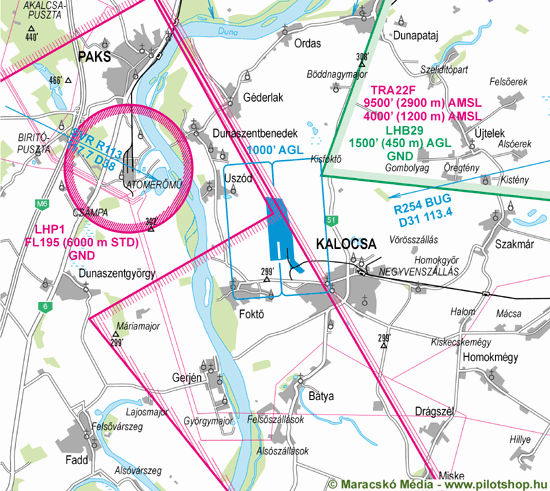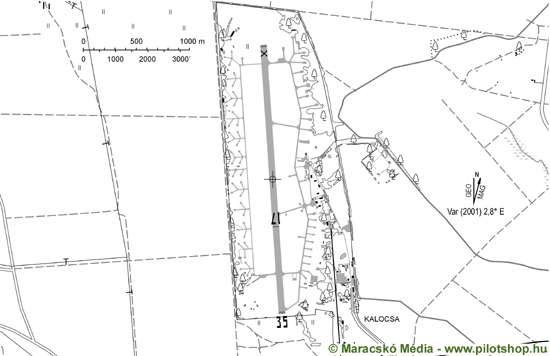 Kalocsa
Kalocsa
Validation date: 08 10 2013
Updated on: Never
Views: 5911
See on the interactive map:
46°33'03.95"N 18°56'35.19"E
17/35 - 2500x60m - concrete (only southern 800m usable)
Kalocsa airfield (Hungarian: Légierő reptér Kalocsa, Also known as Fokto or Калоча Фоктё авиабазы, ICAO: LHKA) was an air base 100 kilometers south of Budapest.
It was built sometime around 1950 by the Hungarian military. Between 1951 and 1956 it served as a Hungarian Air Force military airport, only the fighters of the Hungarian Airforce used the airport and the airspace.
After the Hugarians tried to escape from communism in 1956, the Soviet Army came to Hungary. Their helicopters and their MiG-17 fighter-bombers of the 14th Guards.IAPused the airport and the airspace. The airspace was strictly forbidden for civilian and sports flying, forcing local aviation lovers to the aeroclubs of Szeged, Kiskunfélegyháza, Szolnok, Budapest and Baja. The fighter bombers remained until 1960, when they relocated to Kiskunlachaza. Then, under the supervision of MHSZ (Hungarian National Defence Association) pilot and parachutist training was to be provided by specialist organisations to the army. Although Kalocsa was deprived of the use of its airport, it had many air enthusiasts as these trainings were free. A cooperation agreement was signed in 1966 by the Headquarters of the Soviet Southern Army and MHSZ, which made it possible for Hungarian parachutists to jump from Soviet helicopters at the airfield. In 1969 the Hungarian national Parachutist Team was the guest of the Soviets, too. However, this possibility came to an end in 1971.
The Soviets built barracks and blocks of flats near the airport and equipped it with more than 60 helicopter parking pads on both sides of the runway. They used the airfield under the callsign "Verchovod". Also, just as in the case of other territories used by the Soviet Army, after the troops had left in 1990, very extensive environmental pollution was discovered at the airfield.
After the withdrawal of Soviet troops, an estimation of damage and an attempt to stop soil pollution began. Unfortunately, it was forced to stop because of financial constraints.
The reorganisation of local airsports began through the efforts of Bácska Hang-gliding Club, functioning in the area of Baja and Kalocsa. Also, there were attempts to use the airport for the 1996 World Fair. The very high initial price and later the cancelling of the World Fair killed the interest.
Although there were few offers, the airport remained a closed object without an operational permit. The buildings and runway were under armed protection, but left unprotected from weather conditions. The hanggliders of Bácska Aeroclub rented a hangar and a couple of hundred-meters long grassy area on the northern part of the airport. The initiative meant flying continued at Kalocsa. They also established the Flyers for Kalocsa Fund, whose aim was to help Kalocsa and its environment progress by keeping at least this area. Also they offered the police and the fire brigade their machines to assist in their work in the fields of air observance and photography. Parachuting became more and more popular at Kalocsa. In addition to the growth in the number of parachutists, their professional level rose significantly, and they organised successful training camps with international participation.
An LRI (Aviation and Airport Management) survey was carried out concerning Airport Kalocsa. It proposed to separate the barracks, the fuel storage, the airport area and other buildings and areas. This would make it possible for sports flyers to prepare their plans to use the airport in its original function. However, in May 1995 a project was discovered in which the airport would be converted into a surface oil storage. Rumours circulated that a group was to buy the airport for this purpose. This would mean the end of the airport and the regions chances for potential progress. At the same time, the construction of such oil storage would be very dangerous for the inhabitants of Kalocsa because of the prevailing northwestern wind direction and the closeness of the densely inhabited areas. The airsports enthousiasts would have been forced to a grassy area near the dumping ground of Kalocsa, which is not suitable for aeroplanes and parachutists. Naturally it would not promote the progress of tourist industry and economy of the region, either.
In August 1995 the sports flyers organised open days and as the event was widely advertised, it became very successful. This proved that with proper professional arrangements the conceptions of using the airport by small planes would be realistic. In connection with the success of the event, a long-considered idea was brought to life on 11th October 1995: the Aeroport Kalocsa Flyers Association was formed.
On 25th October 1995, the secretary general of MRSZ (Hungarian Aeronautical Association) visited to Kalocsa. He outlined a new concept according to which the establishment of the National Flyers Fund was under way. This Fund would run Kalocsa airfield under control of sports flyers. On this occasion, it became evident that the three flight organisations (the Club, the Bácska Aeroclub and the Flyers for Kalocsa Fund) would join forces through the Aeroport Kalocsa Aeronautical Club, supported by MRSZ. At the end of October the proceedings necessary for authorizing the airfield and the collection of official licenses began. The Association started its first sailplane pilot training.
In November, American representatives of IFOR (the peacekeeping forces for Bosnia-Herzegovina) inspected Kalocsa airfield as an alternative base for a potential Baja depot. Unfortunately, instead of Baja, IFOR chose Pécs.
By December 1995, the management of the Club collected a large number of supporting statements in the interest of putting the airport into operation.
In the meantime the realization of the National Flyers Fund significantly slowed down and the case of the airport s privatization got to ÁPV Rt. (the governmental organization to control the privatization process in Hungary).
Because of these reasons, the preparation of a project to find a solution that serves regional and national interests became justified. Thanks to the efforts of the managing director of the Club the airport obtained a temporary operational permit in February 1996.
Between 1-11 March the Aeroport Kalocsa Flyers Association organised a Flying-Parachuting Exhibition to draw the public's attention and to prove that the nearly hundred pilots and parachutists and their intentions were serious.
One of the villages (Uszod) in the region did not sign the temporary permission for 1997. This meant that airfield activity was to be restricted to a limited part of the airfield. Rumours suggested that a company paid money to Uszod for the part now owned by the village. This company dealt with the trade in not only oil, but also environmentally hazardous materials and waste. A civil initiative to prevent establishing a hazardous depot just next to Kalocsa on the former airbase was started.
The Aeroport Kalocsa Aeronautical Club continues its activity, organizes programmes on the part of the airfield belongs to Kalocsa and Foktõ. The local authorities and the mayors of Kalocsa and Foktõ decided to establish an industrial park and invite investors to the territory of the the former base. If the local authority of village Uszod reverses its decision to sell its part to that company, the airfield can be kept for flying next to the industrial park.

Approach map for the airfield as presented on HungaryAirport.hu in 2013

2013 Aerodrome chart showing only the southern 800meter of the runway is usable due to a dispute with neighbouring Uszód. As a result of the dispute, the northern half of the runway does not have a permit to be used (HungaryAirport.hu).

The airfield looking north (aviationfanatic.com).
The information on this airfield was largely compiled by using information of the Aeroclub Fokto-Kalosca